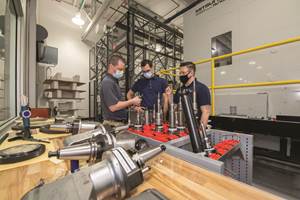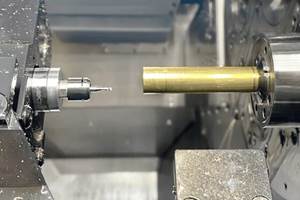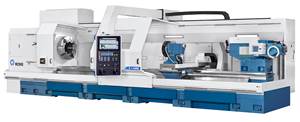Teach-In CNC Lathes Improve Shop Productivity
Because of the critical nature of the parts this shop's customers demand, speed and accuracy are major factors when considering a profitable way to machine them. Read how this CNC lathe meets both demands.
Mark Campbell of A.M. Machining (Hilliard, Ohio) knew that he had to do something to replace the manual lathe for his machine shop, which specializes in prototype parts, tooling fixtures, jigs, CNC milling and CNC turning. The manual lathe was too slow at producing parts and not able to hold repeatability from part to part. "My customers have production lines which cost them in the tens of thousands of dollars when they go down. I need to get them these spare parts immediately," he says. Because of the critical nature of these parts, speed and accuracy are major factors when considering a profitable way to machine them. Many of these critical parts are placed in orders of only one to five pieces ranging from ¼ inch to 20 inches in diameter and weighing up to 300 pounds. These parts were previously machined on a Calusing 17 by 80 inch manual lathe, which was no longer able to keep up with growing customer demands.
Mr. Campbell decided that he needed a CNC lathe to solve these production problems. His requirements included 18-inch swing, 60 inches to 80 inches between centers, ease in programming, G-code functions, capable of doing manual moves by way of handwheels, spindle speeds anywhere from 200 to 2,000 rpm, constant surface speed, and an industry proven CNC control. Mr. Campbell contacted Paul Kerschensteiner, a long-time trusted friend, for advice.
Mr. Kerschensteiner of Industrial Machinery (Columbus, Ohio) had come across a new type of CNC lathe that had the features that Mr. Campbell was looking for, the Digital Control Lathe (DCL) from Victor (Ranch Dominguez, California). The DCL was even designed for a manual shop wanting to transition to CNC without spending a lot of time in the usual training process. Mr. Campbell decided to purchase it since A.M. Machining had no previous CNC lathe experience.
The Victor 1860DCL was chosen for many reasons. It uses an industry standard Fanuc 20-TA as its CNC; it has an 18-inch swing with a 60-inch bed; constant surface speed standard; and a maximum spindle speed of 2,500 rpm. The control panel is equipped with three electronic handwheels to allow the operator to manually run the machine in the X, Z, and special "machine guidance" directions. The "machine guidance" direction corresponds to whichever movement is currently programmed into the CNC; its handwheel can even allow the operator to manually jog the machine along any part program point for point.
Because the DCL uses simple graphics conversational screens for data input and a true teach-in feature to create part programs, the operators were able to start using the machine with very little training time. In this machine's first few months, most of the work was done in the manual and teach-in modes of the control. These two modes made the transition from manual machining to CNC machining very simple for the operators. The operator has to machine the first part using a combination of graphic conversational screen prompts and handwheel movements. After it is completed, the teach-in processor automatically converts all the movements to G-codes and a part program is automatically created. The operator just loads in the second blank part and presses the "PLAYBACK" pushbutton to get an exact duplicate of the part. This teach-in functionality memorizes the machine movements and all other auxiliary functions that are pressed as well, such as spindle speeds, coolant, constant surface speeds, and so on. No editing of the part program is required to make subsequent parts.
The machine guidance conversational screens make it easy to program the machines to automatically cut a variety of cycles, including profiles, threading, grooving and drilling. With the implementation of this machine, A.M. Machining has been able to cut setup time in half and increase productivity by 62 percent. "The Victor DCL has almost tripled our overall production," Mr. Campbell reports.
In addition to the Victor DCL solving A.M. Machining's low volume production problems, the automated power of the DCL also allowed new higher volume work to be quoted. "We are now able to take on some large volume orders that would have previously taxed our capacity," says Mr. Campbell. "The bottom line is that the Victor DCL has also allowed me to increase my sales and make deliveries on time."
Related Content
Threading On A Lathe
The right choices in tooling and technique can optimize the thread turning process.
Read MoreDigital Twins Give CNC Machining a Head Start
Model-based manufacturing and the digital thread enable Sikorsky to reduce lead times by machining helicopter components before designs are finalized.
Read More3 Tips to Accelerate Production on Swiss Lathes with Micro Tools
Low RPM lathes can cause tool breakage and prevent you from achieving proper SFM, but live tooling can provide an economical solution for these problems that can accelerate production.
Read MoreRomi Launches Flatbed Lathe for Machining Large Parts
The C 1100H is a heavy-duty flatbed lathe built with a monoblock cast iron bed that absorbs machining efforts and vibration, making it highly rigid, stable and accurate.
Read MoreRead Next
3 Mistakes That Cause CNC Programs to Fail
Despite enhancements to manufacturing technology, there are still issues today that can cause programs to fail. These failures can cause lost time, scrapped parts, damaged machines and even injured operators.
Read MoreThe Cut Scene: The Finer Details of Large-Format Machining
Small details and features can have an outsized impact on large parts, such as Barbco’s collapsible utility drill head.
Read More






.jpg;maxWidth=300;quality=90)
.jpg;maxWidth=300;quality=90)

















